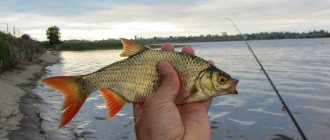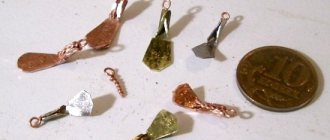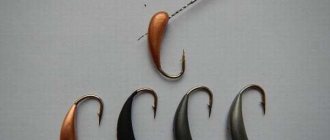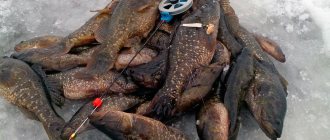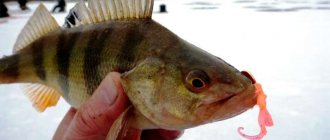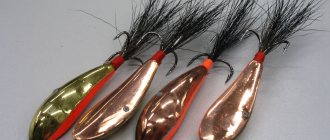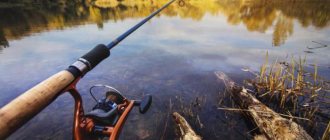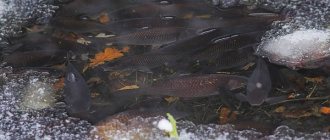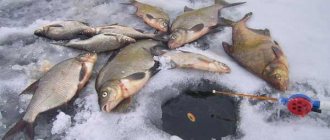Advantages and disadvantages. Mormyshka or Float?
Why is catching roach in winter with a jig (with a nod) much more common than with a float rig? Have you ever wondered?
Advantages of Mormyshka over Float Equipment:
It is possible to fish both with bait and without bait;
Also, the jig is superior to the float in terms of catchability;
Active and dynamic fishing, which cannot be said about fishing with a float;
Opportunity to get creative with fishing. Change jigs, variations of jig play, depending on depth, current, and other external factors;
As with a float, it is possible to use both active and passive fishing.
As for the disadvantages, they also exist:
It is not convenient to fish with a jig at great depths;
In case of strong current;
Well, in those cases when, for reasons unknown to us, the roach simply refuses to respond to the jig, but prefers a regular hook with a nozzle.
Bait for roaches in winter
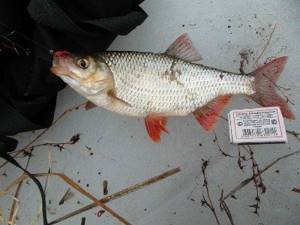
The feeding hole should be cut no further than 40 cm from the main hole, and be sure to take into account the current so as not to be left without fish completely. The tightly compacted bloodworms are placed in an iron feeder and lowered into the bait hole. If the bottom is soft (muddy), then it is advisable to open the feeder with bloodworms at a distance of approximately 40 cm from the bottom; if it is rocky, then 5 cm will be enough. Depending on the preference of the fish in a particular body of water, bloodworms can be mixed with a tubifex or worm.
If the depth in the reservoir is not very deep and the bottom is muddy, then you can tap the bottom with a pole from time to time, which will raise turbidity, which is of great interest to roach, rudd, bream, and silver bream.
In addition, you can feed the roach 2-3 days before the main fishing, placing the bait in the same place every day. In this case, it is advisable to do this at the same time, as a result the fish will again wait for the next portion of bloodworms.
Catching Roach in Winter. Types and Characteristics of Jigs
As you have already learned, roach is caught using a jig both with and without a nozzle. Using both active and passive fishing methods. Not every jig is suitable for every fishing method. They all differ in shape, material, weight, number of hooks, colors, and so on.
Catching Roach in Winter with a Jig with a Nozzle
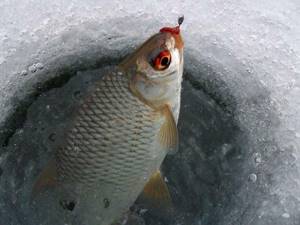
Mainly the following jigs are used for attachment:
Drobinka . A regular jig with one hook, made in the shape of a ball;
Ovsinka . It has an elongated oval shape, it comes with or without edges;
Ant . The shape of the jig actually somewhat resembles the body of an ant. It also has one hook;
Uralka . A popular jig, shaped like an elongated drop and slightly curved to the side.
All these jigs for roach have only one hook.
Nozzle jigs for Roach
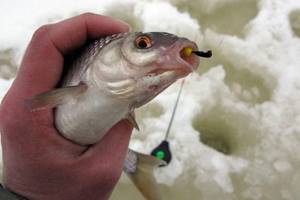
Let's list some of the most popular baitless jigs for catching roach that are used by anglers:
Uralka . Yes, yes, you understood everything correctly. This jig is suitable for fishing without bait, and also with one hook;
Goat . The shape of the jig is somewhat reminiscent of the Uralka, but with two hooks;
Devil . A very popular jig. It has 3 hooks and is perfect for active roach fishing.
Choosing a jig for catching roach
A jig is an artificial bait that consists of a body of various shapes and a soldered hook. All of them are divided into two types:
• with bait – bait is used;
• reelless (baitless) – the fish bites on a hook without bait, reacting only to the play of the bait.
Now there are a huge number of jigs of different colors, sizes and shapes. The choice of bait is largely determined by fishing conditions and biting activity. The most catchy jigs for catching roach in winter have the following characteristics.
1. Material: • tungsten – the heaviest jigs, used for fishing at great depths and in places with currents; • tin – the lightest, suitable for shallow water; • lead – the most versatile and frequently used bait.
2. Size – up to 4 mm . The size of the jig largely depends on the activity of the fish - the worse the bite, the smaller the bait is used.
3. The color depends on the weather and the mood of the fish, so it is selected in practice during the fishing process.
General recommendations:
• the color of the jig must match the color of the food, so black, dark green, dark brown and gray baits are often used. The fish also goes well with baits of natural colors of brass, copper, and lead.
• at great depths (from 4 meters) you can try light baits - copper-colored, yellowish and reddish shades. Also, light jigs are suitable for cloudy weather;
• for fishing at significant depths (8-9 meters), phosphorus-coated baits perform well;
4. The most catchy models:
- pellet;
- crap;
- larva;
- a drop;
- ant;
- Ural
Mormyshka color. Which is better?
There are no strict rules in the color of the jig; it is possible to use different color variations. Most anglers believe that the color of the jig is influenced by the depth at the fishing spot. The larger it is, the brighter and lighter the jig is selected.
The most working color for nozzle jigs is black. It is the black color of the jig that most fishermen prefer.
Important. When using a jig in a float rig for standing fishing, the best results were shown by jigs with a luminous (phosphorus) color. Moreover, they work equally well both during the day and at night.
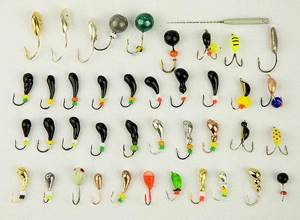
Choosing Jig Weight
The Weight of the Chosen Jig is Affected by Several Factors:
- Depth at the fishing spot;
- The strength of the current;
- Line diameter.
For active jig fishing, heavy weight is not necessary. The optimal weight of the jig should be such that the nod under its weight bends by ¼ of the entire bend. If you decide to fish standing, then the weight of the jig can be increased.
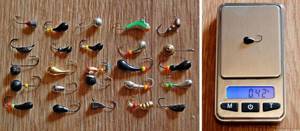
Groundbait and bait
Lure. In winter, feeding the holes will help attract fish. For roach, you need to make the bait in such a way that it dissolves a little earlier than the bottom, creating a cloudy nutrient cloud in the water column. Main components of bait:
- powdered milk;
- breadcrumbs;
- semolina;
- bran;
- Wheat groats;
— bait (bloodworms, maggots, etc.)
At shallow depths, the bait is thrown into the hole by hand. If fishing occurs at a depth of more than 4 meters, then you need to use a bait feeder, opening it a meter above the bottom level.
Baits. In winter, roach, like other fish, prefers high-calorie foods, mainly of animal origin.
Basically, in winter, when fishing with jigs, they use bait from bloodworms, maggots, burdock moth larvae, caddis flies, and pieces of red dung worm. In rare cases, when the fish refuses to take animal bait, they try fishing with bread and dough.
Mormyshka Manufacturing Material. Is He Important?
Common materials for making jigs: lead and tungsten. Jigs made of lead are cheaper than jigs made of tungsten, and are usually lightweight, even with large sizes.
Tungsten jigs are made from rods or tungsten powder. The main advantage of a tungsten jig is that, despite its smaller size, it has more weight.
Tungsten jigs are excellent for fishing at depth, as well as in shallow water, if the roach suddenly prefers small jigs instead of large ones. For tying fishing line, the jig has a flared hole so that the fishing line can be rubbed and not cut on the edges.
Some fishermen seal a suitable-sized cambric into this hole, which also has a good effect on the durability of the equipment.
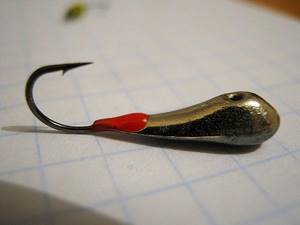
Active game fishing
Winter jigs for roach for fishing with bait are essentially hook weights with sufficient weight to quickly deliver the bait to the bottom, and also make it possible to perform a certain game coupled with a nod. Color and shape are secondary characteristics. The main thing here is weight, selection of line thickness and adjustment of the nod for this particular bait and fish. The main feature is versatility. If the main time for fishing with a reelless bait is the first and last ice, then fishing with a jig brings good results even in the dead of winter. Lead or tungsten jigs for roach are more often used. Lead ones are cheaper, but tungsten ones have a much higher specific gravity. The best option for roach in the dead of winter is small and inconspicuous heavy tungsten jigs made from a single rod. Such baits are expensive, but they are worth it.
Be careful if you are offered cheap tungsten products. These are either fakes or they are made from tungsten powder by sintering. Real rod baits are made by turning, which is labor-intensive and, accordingly, cannot be cheap. For fishing in shallow water, light tin jigs are used. Plastic baits are also often used, which are used on additional leashes.
Tackle for Fishing with Mormyshka
If we talk about active and passive fishing, then the gear differs in its functionality.
Rod for fishing
Choosing a fishing rod is quite simple. Regardless of how you plan to fish, with or without an attachment, the best option would be a regular balalaika with a built-in reel. As you can see, nothing supernatural.
If you plan to fish with a float, then it is best to use a fishing rod with legs, so it is convenient to place it in front of the hole. In addition, it is much more stable in windy weather.
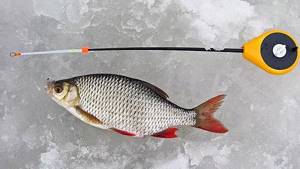
Fishing line
For active fishing, with an attached or no-attached jig, you should not use a thick fishing line, since with such a fishing line you will not achieve better animation of the jig.
The optimal diameter would be a fishing line not exceeding 0.14 mm. When standing still, you can choose a thicker fishing line. But here you should be guided by the size of the fish being caught, rather than by the performance of the bait.
Nod selection
The nod is also selected from the fishing methods. The more active the fishing, the longer the nod. A long nod allows for the highest quality jig animation. And at the same time, a long nod is useless if you catch roach with a float, or with a jig with a nozzle, using a passive method.
Material for Making Nods:
Lavsan;
Clock spring;
Boar bristles;
And others.
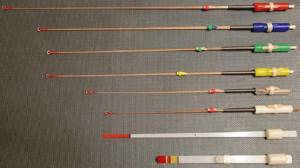
Types of fishing rods
Winter fishing for roach with a jig is probably the most common method of fishing for this fish in the cold season. And it means several types of gear:
- Using a jig in float gear,
- Fishing from the bottom with a nod,
- Active fishing with a jig with bait,
- Fishing with a reelless bait (without bait),
- Special gear for strong currents.
This article examines in detail how to catch roach using a jig. Other methods are described in detail in the relevant articles on our website.
Winter fishing rod equipment
To catch roach, a jig fishing rod is mounted thin and elegant. If in sparsely populated areas, where there are a lot of unafraid fish, fairly coarse tackle is used, then in the reservoirs of the middle zone the principle “the thinner, the more bites” fully works. It is important to understand that there is no “best” equipment. There is only a working one, for a specific place, time and method of fishing. In any case, when fishing for the game, light and small jigs and, accordingly, thin fishing lines are used. This fishing method is relevant for fishing at depths of up to 5 meters. At greater depths, it is difficult to control a light jig - here it would be better to use a float tackle or donka with a retractable leash, a nod and a heavy sinker at the bottom.
The components of the equipment are a fishing rod, a nod, a fishing line and a jig. The work of the nod depends on the weight of the bait and the fishing depth, since as it increases, the friction force of the fishing line on the water increases. For the most cautious roach (for example, in the Moscow region), small jigs and thin fishing line (0.08-0.1mm) are used. Where the fish are larger and bolder, a 0.12-0.14 fishing line and larger baits are suitable. A small jig on a thick line will take too long to sink to the bottom; a heavy bait on a thin monofilament does not play well. The ideal option is a separate tackle for each case, so as not to tie the same fishing rod ten times on a pond.
Fishing rod
The choice of fishing rod is secondary; the nod is more important. The main thing is that it is comfortable for the fisherman to hold it. Many options are available for purchase in stores, and fishermen also make fishing rods themselves. An excellent option is special, ultra-light homemade or store-bought fishing rods.
Nod
The nod to the roach is the most important part of the equipment. This element of the tackle not only transmits the bite, but ensures the correct play of the jig. And if perch requires sharp high-frequency vibrations, and for bream, on the contrary, smooth and amplitude ones, then for roach it is something in between these two. The ideal option is a homemade nod made of lavsan, boar bristles, dense polyethylene, polycarbonate or x-ray film, specially made for roach and for a certain weight of the jig (it is better to customize individual nods for each type of fish).
Store-bought metal and plastic nods are quite suitable. They have a number of disadvantages, since they are made, in fact, for the purpose of sale, and not for fishing. They are suitable for nodding tackle when fishing from the bottom to a riser. For active game fishing, you need a special option - a special nod for roach in winter. Experienced people already know this. But if you are a beginner, I highly recommend being patient, spending time and watching this video:
If you do not want to make nods yourself, then you need to be very careful when choosing a guard in the store. You may have to modify it, and when collecting gear at home, select the correct nod for a certain weight of the bait. The nod for the roach should bend under the weight of the bait by a quarter of a circle and make smooth, uniform oscillations when swaying. Refinement consists of selecting the length and grinding the surface of the form onto a cone using sandpaper.
At What Time Are Roaches Most Active?
The most promising time of year for roach fishing is November-December, and March-April. Accordingly, as you already understood, this is for the first and last ice.
3 ways to improve your fish bite!
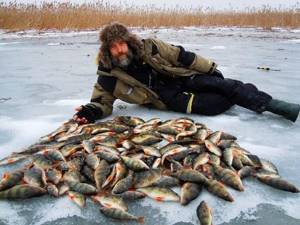
Over 15 years of active fishing, I have found many ways to improve the bite, and here are the most effective:
1. Bite activator . This pheromone additive attracts fish most strongly in cold and warm water. The Fish Hungry bite activator has proven itself to be excellent - Read more…
2. Tackle with increased sensitivity . You should first familiarize yourself with the features of using a particular type.
3. Pheromone baits . They attract the attention of fish, stimulate hunger and cause a schooling reflex, which allows you to collect a lot of fish in one place.
You can get the rest of the secrets of successful fishing for free by reading my other materials on the site.
3 ways to improve your fish bite!
Over 15 years of active fishing, I have found many ways to improve the bite, and here are the most effective:
1. Bite activator . This pheromone additive attracts fish most strongly in cold and warm water. The Fish Hungry bite activator has proven itself to be excellent - Read more…
2. Tackle with increased sensitivity . You should first familiarize yourself with the features of using a particular type.
3. Pheromone baits . They attract the attention of fish, stimulate hunger and cause a schooling reflex, which allows you to collect a lot of fish in one place.
You can get the rest of the secrets of successful fishing for free by reading my other materials on the site.
At this time, roach can be easily caught using almost any method: a jig with or without a nozzle. But in the middle of nowhere, it’s best to stand still. Moreover, the use of bait is mandatory.
As for the time of day, everything is ambiguous here. Catching roach in winter can be successful both during the day and at night. There are, of course, declines in the bite, but this is not always and not everywhere, it all depends on the place and the method of fishing. Of course, a sudden change in weather can also have an impact, we’ll talk about that later.
Active game
The most important point is the game itself with the jig. And this is a field for the fisherman’s experiments. Each fisherman develops his own skills over time. But general trends can be indicated. As already mentioned, roach prefers a smoother, slower, more measured game than, for example, perch. There are several well-known methods of placing bait, with which you need to start and apply them all on the hole until you find one that works right now in this particular place. It is important to understand that the game differs depending on the time of year. Fishing on the first ice requires more active play with a jig than in the dead of winter. In addition, on every fishing trip it is necessary to find the fishing horizon, since, depending on atmospheric pressure and other factors, roach can stand and take bait at the bottom, above it, or even halfway through the water.
Descent
Drop fishing is the most obvious way to play. This is where you need to start. To implement this method, you need to slowly lower the jig down at a speed of about 1 centimeter per second. If there are no bites, then the game should be diversified by pausing for a few seconds. Most often, a bite occurs during a pause.
Intermittent descent
The bait is not lowered evenly, but in pushes of 1-3 cm with pauses after several pushes. By lowering the bait at the beginning of fishing, you should check the entire last meter of water at the bottom.
Lifts from the bottom
The next way to play is to tap the bottom a few times, move it, then slowly lift it by 2-3 cm and pause for a few seconds. Then tapping on the bottom again. And again the rise. The bite, again, most often occurs during a pause.
Climb
We do the same as when lowering, only on the contrary, we raise the jig either with pushes, or evenly. Both options with pauses.
During the game, you need to experiment with methods, sometimes interweaving combinations and cycles, changing the speed and intensity of the elements. Catching sorog in winter with a jig is a creative process. This must be done until the horizon and the most catchy game are identified. After that, we continue to fish using the method we found.
If the depth and width of the hole allows, then you can drag the bait along the bottom. Sometimes this also brings bites. The main thing is to make all movements slowly and smoothly, otherwise the perch will be more likely to be tempted by the bait, not the roach.
Catching Roach on the River in Winter
On large rivers, roach can be successfully caught in both weak and strong currents. The basis for successful fishing will be properly selected and high-quality bait for fishing in cold water.
For places with weak currents, attention should be paid not only to bait, but also to the bottom topography. It is desirable that the bottom be uneven, depth differences of 0.5 meters, driftwood, grass and algae.
There were also good results in places with reverse currents, be sure to take this into account. On small rivers, roach can be caught wherever the living conditions are suitable for it.
At the beginning and end of winter, look for it in shallow water, in the middle of winter, on holes and edges, closer to the riverbed. You can read in detail where to look for roach in winter here.
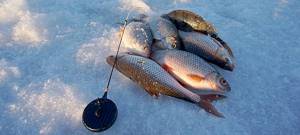
Catching Roach in Winter on the Reservoir
The principle of catching roach on a reservoir is practically no different from catching it on a large river.
Basic Signs:
Vegetation on the Bottom;
driftwood;
Sticking out of the Water, Frozen Bushes, Trees, Reeds or Reeds;
In Glukhozimye the signs are the same, only closer to the riverbed, at depth.
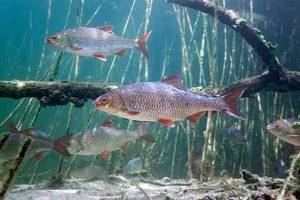
Fishing Features
They start fishing with jigs on the first ice. As soon as it becomes possible to go out on “solid” water, you can take an ice pick, tackle and go fishing. At first, “penguins” come out to shallow bays, oxbow lakes, lakes and ponds, and as the weather gets colder they move to larger areas of water.
By the middle of winter they don’t stop fishing with jigs. This is one of the few ways to stir up passive and lethargic fish, which are reluctant to respond to the offered bait. Experienced fishermen know some secrets that allow them to achieve results even in such unfavorable times.
At the end of winter, on the last ice, jigs are also among the first directions of ice fishing, allowing you to successfully and consistently fish in rivers, reservoirs and enclosed reservoirs. It works especially well during this period on roach and perch.
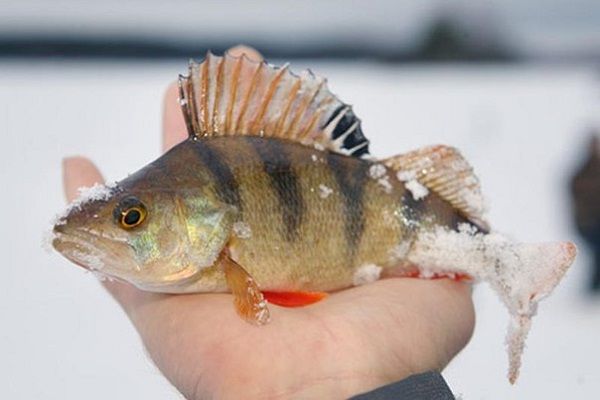
Perch is the main object of winter jig fishing
Fishing with jigs in winter is conventionally divided into diametrically opposite directions:
- baited or with natural bait;
- nozzle or rewinder.
The first option involves hooking some kind of natural bait. In 90% of cases, bloodworms play its role. In this direction, the main role of the jig is to deliver the bait to the fishing point. The fisherman just has to decide whether to leave it motionless or play along to increase the number of bites.
Note! A jig is a relatively passive method of fishing. Reelless, on the contrary, is active fishing.
Reelless fishing differs in many ways from bait fishing. Here the jig is the basis of the bait, which, due to its play, vibrations, and “sound,” attracts the attention of the fish. To increase its effectiveness, various additives are used:
- beads;
- cambrics;
- pieces of chain;
- threads;
- sequins and more.
The fisherman, with the help of finely tuned gear, gives the jig the action necessary to force the fish to bite. By changing the action of the bait and constantly moving, you can achieve impressive results at any time of winter.
The influence of weather on the Roach bite
It is impossible to say with 100% accuracy, but according to the notes of fishermen, roach is most active at low atmospheric pressure.
In frost and clear, sunny weather, the roach bites worse. Cloudy or cloudy weather is much more favorable for roach fishing. The sudden change in weather did not affect the bite in most cases.
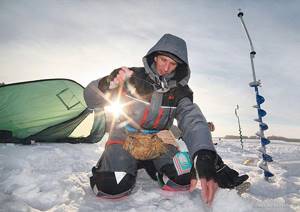
Catching Roach in Winter. Search and Fishing Tactics
Tactics begin with searching for roach in the pond. If you come to a body of water that is unfamiliar to you, then the search for roach usually begins by drilling holes near the shore, gradually moving towards the depths.
For searching, jigs with and without attachments are used. A jig without an attachment allows for more active play, while a jig with an attachment allows for smoother and calmer play.
The main goal is to catch at least one. And since roach is a schooling fish, we can say with confidence that you have found a potential fishing spot.
Next, you need to be sure to feed the point and stay in this place longer. In any case, if you have found the right place, the roach will respond almost immediately.
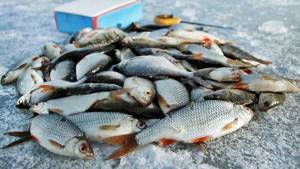
Features of winter fishing for roach
After the first cold and frosts hit the reservoirs, the process of freezing begins. It is at this time that the highest level of roach activity and biting is observed. The fish moves in thin water at a depth of 2-3m in the hope of finding food. You should look for it close to the shore, but you can also examine snags and holes. Usually, in an unfamiliar body of water, it is better to start searching for it from the very shore.
From mid-December to February, roach becomes less active and practically does not move around the reservoir, so tempting it with bait is quite problematic. She doesn’t feel it even 10 meters away. In such cases, you need to find a school and throw bait right under the fish’s nose. But even here, luck largely depends on playing with bait and choosing the right place on the river. Fishing for roach in winter is highly dependent on the weather. With strong pressure surges and in fairly severe frost, there is no bite at all. The most active bite is observed if the weather is cloudy, with a slight breeze or there is a thaw. The time of day does not affect much, but the best activity is observed in the morning and before dusk. And if the hole was well fed, the fish can bite until late at night.
Reasons for the Absence of Biting
The most common reasons for which a roach categorically refuses to peck:
Weather. Unfavorable weather for roach fishing. Read above;
Incorrectly chosen tactics for catching and searching for roach. Read above;
The gear and accessories are installed incorrectly. Read above.
Mistakes That Fishermen Often Make. Here is a List of the Most Frequent Errors:
Unbalanced tackle, incorrect equipment (thick fishing line, unsuitable jig in weight and size, inappropriate nod, and so on);
Incorrectly selected jig or other bait or attachment;
Wrong choice of fishing location, errors in search tactics;
Incorrect fishing technique and bait animation.
Secrets of Successful Roach Catching from Professionals
The Most Useful Tips and Additions from Experienced Anglers:
When fishing with a no-attachment jig, 10-15 centimeters higher up the line, tie a regular hook with a nozzle;
Additionally, they attract fish by tying small antennae made of thread onto a reelless hook;
Many anglers carry a set of colored markers, thereby changing the color of the jig in search of the best response from the roach.
We are coming to the end of our article. If it was useful for you, and you learned something new for yourself, then we didn’t write in vain. An excellent video on the tactics and techniques of catching roach, will brighten up the ending of our material.
Fishing technique
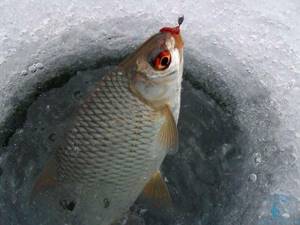
We catch a track in winter using game tactics:
- Slowly, without sudden movements, we plunge the jig to the very bottom. Then, just as slowly, we raise it about 5 cm and freeze for a couple of seconds.
- Then we lower and raise again. As a result, the nod swings.
- Now we lower the jig to the bottom and pull it up 25-30 cm, while achieving intense vibrations.
- Again we slowly immerse it to the bottom and hold it there without the slightest movement. Next, we begin to stir slowly.
- When lifting the jig up, we make small jerks and swing the fishing rod to the sides. At the desired depth, we stop for a while and move the jig.
- After lifting, we quickly lower the jig to the ground and knock several times to muddy the water and attract fish.
- We pull in the bait, gradually increasing speed. With each change of pace, we freeze for 1 second.
In a game like this, it is important to maintain a certain pace and take short breaks. The technique for catching roach with bait can be different - it requires a creative approach from the fisherman. You can take the proposed option as a basis and use your own.
It is recommended to watch a video on how to finish a track in winter:
Another method used in winter for catching sorog in reservoirs with a current is by rolling. The technique is quite primitive, so even a beginner can handle it. The photo below shows how the tackle works.
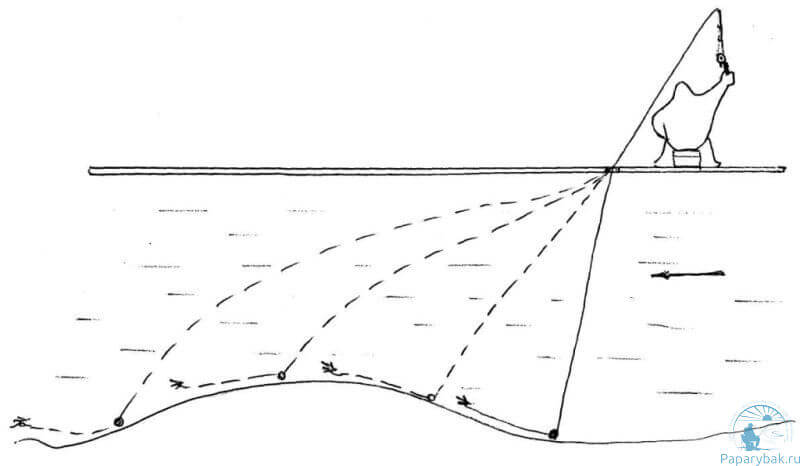
Tackle type "rolling"
The point is this:
- We plunge the sinker into the hole all the way to the ground of the reservoir. We wait until it calms down and fixes itself.
- Then the flow of water picks it up and begins to move it along the bottom. It will be necessary to increase the length of the line by 2 meters so that the load can move away from the hole.
- We stop the sliding sinker and pull it by waving our hand - first we do it smoothly, then sharply.
- We return the tail to its original position and repeat all the maneuvers in the same order.
This approach shows good results, as can be seen in the video:
